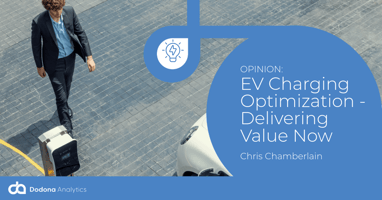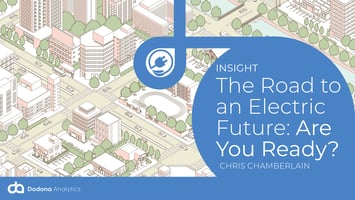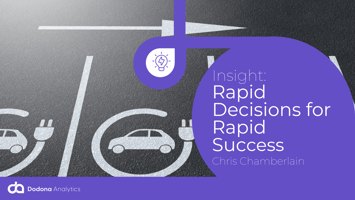There just aren’t enough hours in the day… We have all been there. Stuck in a cycle of muddling...
EV Charging Infrastructure - What can the US learn from Europe?

When it comes to supporting the use of electric vehicles (EVs), there is one thing which stands out as an absolute must - getting the charging infrastructure right off the bat. Chris Chamberlain explores the challenges currently facing Europe, and what can be learnt from them.
EV sales have been steadily increasing over the recent years, but the US still finds itself somewhat behind on the international stage. But this does bring it an unlooked for advantage when it comes to building an effective and sustainable infrastructure for EV charging - it can learn from those mistakes being made elsewhere.
Let's face it - this is all new, for all of us. There is no precedent for setting up a fuel industry which not only has to replace the existing one within a very specific time frame, but is also under immense pressure to convince the consumer to actually use it. In the US, the roughly 2.6 million charge points available to EV drivers in 2022, need to turn in to approximately 9.5 million posts by 2025 and 28 million by 2050 if it is to keep pace with demand. If it fails to do so, consumers may hesitate to make the shift to electric.
It is therefore imperative that we get it right. Being somewhat behind when it comes to EV uptake, does not have to be a bad thing. It can mean that lessons can be learnt from those who may be further along. And yes - I can hear you saying that the US has already been making some mistakes of its own - with reports of unused and neglected charging stations being in and out of its news channels. But there are other tips that can be gleaned from looking at the European situation.
High power demand at peak times
Making sure that the right charger types can be found in the right kinds of locations, and of course, at the right time, is something that Europe is yet to accomplish. The Netherlands, is a good example here, as its high number of chargers is offset by the problems it is experiencing with its national electricity network at times of high demand.
In this situation, rush hour can bring with it long wait times at charge points, before a driver will even get to a charge point, and then the desired charge will take much longer than anticipated due to the strain on the network at that busy time. This combines to make for a lengthy, stressful, and sometimes dissatisfactory charging experience for the EV driver.
Charger anxiety
“Charger anxiety” has replaced “range anxiety” it seems, due to chargers being unreliable in delivering the promised charge (and not just during those peak hours of demand). Drivers no longer worry about how far their vehicle will get them on the one charge, as battery technology has improved sufficiently to largely alleviate this concern.
Instead, drivers now experience a level of doubt when planning long distance journeys (or sometimes even short journeys somewhere new), as not all charging stations can be relied upon to deliver the charge they are promising to deliver.
The root of the problem is often an inadequate connection between hardware and software that cause issues to go undetected, and it keeps drivers uninformed about what to expect before they reach a charging station. Charge point operators need to look to provide appropriate service in this area, as well as ensuring the proper maintenance of their charge points.
A focus on cementing their service regionally before expanding to national levels, could also be key in becoming a reliable charging network in the eyes of the EV driver. In the US especially, we see high levels of underused and neglected charging stations, belonging to CPOs who decided to try running before they would walk, with networks spanning huge distances but lacking in maintenance support.
Charging black spots and social inclusion
These should be avoided at all costs. With the early adopters of EVs tending to be those commanding higher incomes and access to at-home charging, efforts to include other demographic groups are now essential. With charging points being few and far between in rural communities, charger anxiety is a much bigger obstacle to rural EV adoption than it is to urban adoption.
For EV owners living in apartment buildings, charging availability is also a problem, and for those who rely on public charging there is the cost to consider. According to McKinsey, the price of public charging is estimated to be five to ten times more than that of private charging. In the UK it currently costs a diesel driver around 6 pence per mile, versus 24 pence per mile for the EV driver using a paid or ultra-rapid charger. While Europe is facing this challenge after the fact, America has the opportunity to address it during charger deployment, supported by CFI (Charging and Fueling Infrastructure) funds.
Public funding vs private interest
But while policy and government funding does seem to be available in many countries to support the build out of charging infrastructure, it is private companies - Charge Point Operators or CPOs - who are actually getting chargers in the ground. At the end of the day, therefore, it is profitability that will aid charging infrastructure to grow and develop into successful systems EV countries.
This leaves the market in a fragmented state, as each CPO is understandably looking after its own business interests, and not necessarily at the nation-wide picture. For the consumer, this can mean a severe lack of one particular charger type from their local area, or indeed that whole states or counties can be underserved. Again, this will lag EV adoption at least in those areas, if not also further afield, reinforcing the charger anxiety already afoot.
A complex picture
Balancing this need for private profitability against public demand is a tricky one. But along with an awareness of the challenges EV drivers are currently facing on the ground, it is key to creating a successful and sustainable charging infrastructure. It is a complex picture, and planning an effective charging network is not a simple task - especially if you are looking to do so at scale.
As the US continues on this EV transition journey, we are keen to share our knowledge and experience when it comes to site assessment and deployment, to help you avoid some of the issues that Europe is experiencing. Feel free to reach out to us - we are more than happy to discuss how we can help.
Chris is our Co-Founder and Head of Sales. He is an evangelist for eMobility and is passionate about helping the sector make better, evidence-based decisions with data science and AI.
You can follow Chris Chamberlain on LinkedIn




